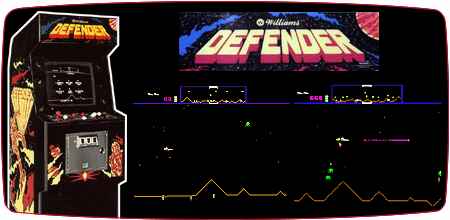Defender

Retro Coin Op Synopsis
On a planet under siege by marauding conquerors from space, a lone spacecraft was the native species’ only Defender. A groundbreaking achievement in video game history, the cosmic hit Defender was all the more remarkable in light of its surprising history.
Before Defender, neither game designer Eugene Jarvis nor pinball giant Williams Electronics had ever produced a video game. Jarvis had come to Williams after a stint at Atari’s pinball division, but the confessed Space Wars addict soon convinced the powers-that-be to let him design the company’s first video game.
After months of work, Jarvis had a rocky planet surface, a field of stars, a spaceship hero, a host of enemies and a name—Defender—but things still weren’t coming together. With the game’s debut set for the Amusement and Music Operators Association convention only two weeks away, inspiration struck. In a fit of programmer’s block some months back, Jarvis had programmed several little walking men at the bottom of the screen. Realizing that Defenders had to defend something, Jarvis made the little men an integral part of the game. After two weeks of feverish round-the-clock programming by Jarvis and his associates, the game was rushed at the last minute to the convention floor.
Defender met with little enthusiasm at the A.M.O.A. convention. The game’s concept was solid: A lone Defender spaceship faced an armada of alien craft, armed only with a front-mounted blaster and a limited supply of “smart bombs,” which would destroy any invader on screen. Enemy Landers would swoop down from the skies, snatch Humanoids from the ground below and carry them up to the top of the screen. If the Lander made it to the top, the Humanoid would be forever changed into a dangerous flying Mutant.
If your Defender managed to shoot the Lander before it reached the top, the Humanoid would plummet toward the ground, forcing you to make a mid-air rescue or lose another Humanoid. If all the Humanoids were lost, the planet would explode in a blinding flash, and your Defender would be faced with a swarm of evil Mutants.
Other aliens joined the attack as well, including Bombers, Pods, Swarmers and the speedy Baiters. The attackers always came in waves, and after every fifth stage, the planet below would be restored to its full quota of Humanoids. It was a lot of information to keep track of, but Jarvis provided the game player with an innovative visual aid. For the first time in a video game, the world was bigger than what you could see on the screen. Your Defender could only cover one small sector of the planet’s surface at a time, so a small “Scanner” at the top of the screen kept tabs on the rest. It seems like a commonplace touch now, but at the time, it was revolutionary.
With all of these plusses in Defender’s favor, why all the negative marks from the A.M.O.A. convention-goers? Simply put, Defender was hard. Too hard, in the experts’ opinion. With an up-and-down joystick, separate buttons for thrust, reverse thrust, fire, smart bomb and hyperspace (allowing your ship to warp to another section of the map), along with a relentless army of hostile aliens, Defender seemed difficult to master. It was, in fact, but that was part of the game’s draw. Local arcade gods had already racked up several million points on Asteroids, Space Invaders and the like, and they were hungry for something more challenging. Defender was the answer, and the masses voted with their quarters.
Sales were phenomenal, and at the next year’s A.M.O.A. convention, Defender was named “Video Game of the Year,” beating out another little game the conventioneers had thumbed their noses at the year before—Pac-Man.
Eugene Jarvis went on to design such legendary games as Stargate (an even tougher 1981 Defender sequel), Robotron: 2084 and NARC. Williams became an industry giant, with successes like NBA Jam keeping the company on top of the game into the 1990’s. And as for the little unheralded game that started it all, Defender has earned more than $1.5 billion to date, all of it in quarters and other small change.
Arcade Machine Release History
1980 - Defender1981 - Stargate
